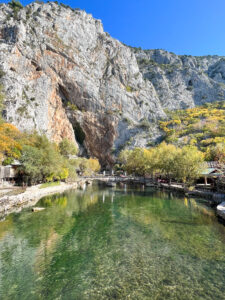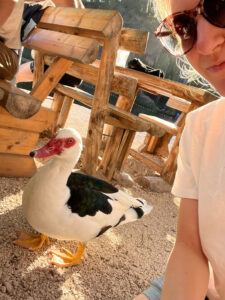
During my entire 5 month-trip, the only place that I went out of my way to visit a second time on my own was Bosnia and Herzegovina. Back in August, Michael and I spent a night in the capital city, Sarajevo, and then a night in Mostar. We arrived in Mostar late in the evening and had to catch our bus early the next morning, and it wasn’t enough. I told Michael then that I was going to go back. There were plenty of other places on my trip that I wished I could have returned to, but geography made this decision easy. I’d intentionally skipped Croatia back in the summer because I wanted to avoid the crowds of peak tourist season, and I planned to visit it in the fall instead. Mostar is the tip of a triangle between both Split and Dubrovnik—just a 2-hour drive from each of them. Most people go to Mostar as a day trip from one city or the other, and a lot of day-trippers are even visiting from cruise ships that dock in Dubrovnik. The town fills up during summer days and then empties out by evening when the day trippers leave. I knew from my previous brief visit that a day trip wouldn’t do the town justice, so I booked one night. Then I thought better of it and added one more.
As the bus left Dubrovnik, we rode higher and higher into the mountains. The odd shape of the Bosnian and Croatian borders meant that we had to cross the border twice—4 different passport checks—which made me feel like I was venturing much farther than just a two-hour drive away. Going to Bosnia this time felt so different than it had the first time just 2 and ½ months prior. The first time I’d arrived not knowing what to expect and having no idea I’d fall in love with the place. Since then, I’d learned as much as I could about the history of the region and became more infatuated with it from afar.
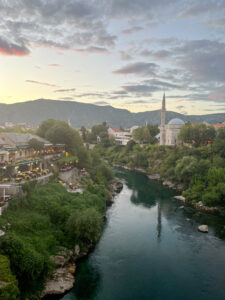

I arrived in Mostar after dark and walked the few blocks to Hostel Majdas, which I picked to stay in because it had a 9.9 rating on Hostel World—the highest rating I’d ever seen. When I first saw the rating as I scrolled through the app looking for a place to stay, I assumed that it must be a hostel with very few reviews. Ratings tend to be high when there are only a dozen reviews, but no—this place had over 2,000 reviews. But even more shocking—most of the other hostels in town had similar ratings. When Michael and I visited Mostar, we’d stayed in an Airbnb. I was curious to see what was so special about the hostels.
The owner, Majdas, greeted me when I came in the gate—she’d been waiting specifically for me to arrive, her last guest of the night. She showed me my private room and where to take my shoes off before entering the house—a custom everyone follows in Bosnia. My room cost $26, had its own bathroom and mini-fridge, and felt like a guestroom in a friend’s house. It didn’t feel so much like a hostel as it felt like her home that happened to have extra bedrooms. (And in fact, it WAS Majdas’s house. I wandered into the kitchen later to wash my dirty dishes, and I found Majdas’s tiny, elderly mother inside. She smiled at me and gave me a wave as if it were totally normal to find strangers wandering through her house at night. Which I suppose for her it is.)
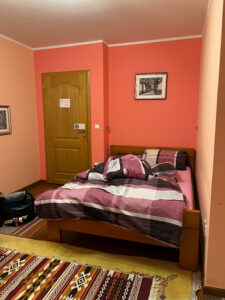
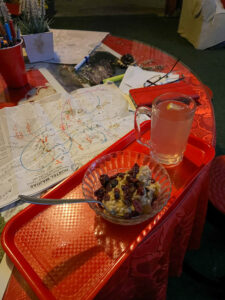
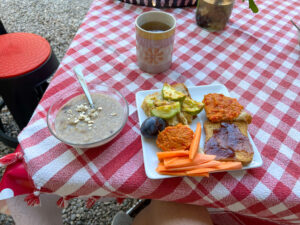
After showing me my room, Majdas brought me to a table in the garden amid hanging flowers and pomegranate trees and brought me porridge and veggie soup—the things she happened to have in her kitchen that I hadn’t even known I was hungry for. It was the off season, and there weren’t many of us staying in the hostel that night, but 3 other guests were outside while I was eating, and they asked if I’d join them on the hostel’s day tour the next day. I was tired, not feeling very social, and not-quite-yet feeling like my normal pre-covid self, and a full-day tour sounded like too much. “There’s 3 of us who are in, but they can only run the tour if 4 people sign up,” they told me. I am a person who is largely immune to peer pressure, but this felt like the right kind of peer pressure to give in to, so I agreed. This was one of the best spontaneous decisions of my trip.
But there were complications with the tour. The owner’s brother usually leads the hostel’s day-tours, but he couldn’t do it the next day on such short notice. So Majdas called the owner of another hostel in town (I believe it was Hostel Nina) and asked him if he could bring us on his tour instead. I liked knowing that all of the hostel owners support one another this way—that they are friends instead of competitors. I figured out the reason that Mostar has a higher concentration of top-rated hostels than I’ve ever seen in a place so small, and it’s not because the accommodations are luxurious. It’s because there’s a warmth and kindness in this town that you can’t fake or mask with fancy amenities.


The next morning was the first morning I felt back to my normal self. Our guide, Zika, picked us up early and brought us back to his own hostel where his family made us omelets. I’d assumed we’d be getting in some sort of van with some of his own guests for the tour, but no—it was just the 4 of us plus our guide, piled into his personal car, sunroof cracked and windows down. Now that summer was over, hostels were no longer full of students on summer break. Guests tended to be older (which is to say, closer to my age), and everyone had a story. All 4 of us were solo travelers. There was Briana from the UK who was on a short trip to the Balkans before a massive and inspiring trip to Central and South America that she expected to take a couple of years. We bonded over our love for every stray dog in sight and photos of our dogs back home. There was Ian, who is from the US but had lived in France for the past 6 years. When I confessed to him that I was afraid of heights and flying, he told me that he used to be horribly afraid of flying too, and to overcome his fear of planes, he joined the military and started jumping out of them. And there was Richard, from Mauritius by the way of Australia. He was far older than the rest of us, and the kind of traveler who gives me hope that travel like this doesn’t have to have an age limit.
We spent 9 hours riding with Zika all around the Southern part of the country (the Herzegovina part of Bosnia and Herzegovina). We drove up a mountain for the view at the lookout point—a glass bottomed walkway jutting out over the cliffside. (I DID step on it for like 5 seconds before hurrying off.) Then we headed to a place that isn’t on most day-tour itineraries—the abandoned aircraft hangar. We parked and walked around a security fence with “no trespassing” signs, and I hoped that we wouldn’t find ourselves in Bosnian prison. The giant, former aircraft hangar was once a secret facility where Yugoslav President Josip Tito kept fighter jets. It’s camouflaged from the road, so you wouldn’t see it unless you already knew where to look. We walked through the massive tunnel and into what used to be the control room. It looks like a bunker from a horror film.
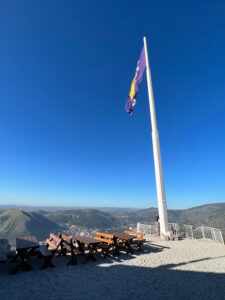

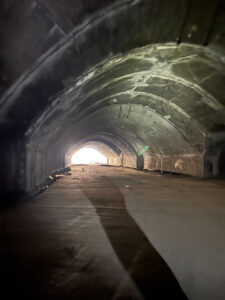
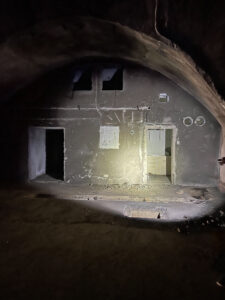
We visited the small village of Blagaj, where Muslim dervishes come and dance in the monastery-turned-museum. It perches over the river which is said to hold mystical properties. Then we headed to Pocitelj, a medieval fortified village that’s considered today to be an open-air museum. We climbed up the steep hillside for a view of the village below. And then in the afternoon, we headed to Kravice Falls—a lake half-surrounded by cascades. In the summer, I assume the waterfalls are crowded with visitors, but at the end of October, there were only a few families. The water was so cold it burned, but the others on my tour were determined to swim anyway because they apparently have superhuman powers. I walked in to just my knees and started quivering. We ate cevapi at picnic tables next to the water and Zika told us about visiting this place when he was a little kid when it was still undiscovered.
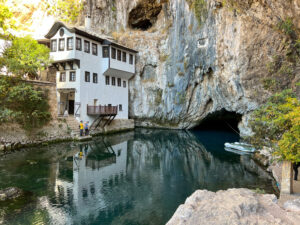



As we wove up and down the mountain roads, he told us about the war. He fought in it when he was 17, and he showed us the shrapnel and bullets that he was hit in the back with (which he keeps in his car now for his tours). Shrapnel is still in his back today. He explained the geopolitical tension in the region and gave us his first-hand experience of growing up amidst this conflict. He answered 9 hours of our questions. On the way back to Mostar, he showed us the cemetery where he dug some of the graves for his best friends and classmates.
The town of Mostar was under siege during 1992 and then again from 1993-1994, a siege that was separate from and quite different from the Siege of Sarajevo a few hours away (which I wrote about in this blog post), but that I’m sure was no less horrifying for the people who survived it. About 90,000 of the 120,000 residents of Mostar fled, but not everyone was able to escape. 100,000 people died in the Bosnian War throughout the country between 1992 and 1995, and over 2 million were displaced. One casualty of the war was the famous Stari Most (Old Bridge)—a 16th century Ottoman bridge that remains the most famous icon of Mostar. It was destroyed during the war, and UNESCO oversaw its reconstruction which was completed 10 years later. It’s Mostar legend that a boy only becomes a man when he makes his first jump from the 79-foot bridge to the water below, and most every man who grew up in Mostar has made the jump multiple times, even during the war—specifically in defiance of the war. They still jump today—tourists (mostly men, but some women, too) from around the world come to the bridge to pay the fee and sign the waiver allowing them to jump. It’s horribly dangerous, but that’s part of the appeal. There’s even an extreme diving competition every summer. Today the bridge serves as a symbol of connection in a town that’s still divided. Zika told us about all the years he made the jump. The whole 9-hour tour cost $40—a price that at the time seemed far outside of my daily budget but now, months later, seems preposterously cheap.
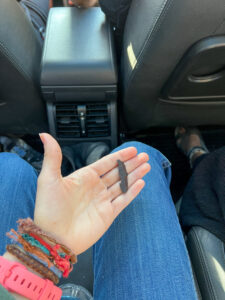

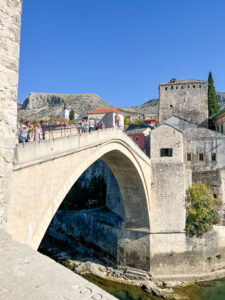
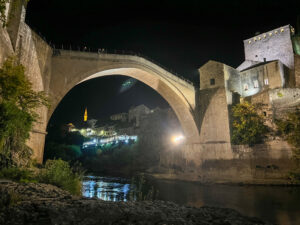
I’d originally booked one night in Mostar, and I added a second night when I decided I might not need as much time in Dubrovnik. When I asked Majdas if my room was available for me to add a third night, she did not seem surprised. The next morning, I had the best free breakfast I’ve ever had at a hostel before heading out to explore. I went to the Sniper Tower, formerly a bank building and the tallest building in Mostar. It was famous for being a sniper nest throughout the war, and today it’s abandoned and full of stunning graffiti from those brave (or reckless) enough to climb inside. (I did not climb inside.) This side of town lacked the glamour of the polished and touristy Old Town. Here, the bullet holes still covered most buildings, and craters from shells still liter the streets.
Back in Old Town, I was in a different world of polished Mosques and Ottoman influenced souvenirs. I bought paintings and postcards and cashmere scarves that the woman assured me were hand-made in Sarajevo like the enthusiastic tourist that I am. And then I went to the Museum of War and Genocide Victims—a tiny museum that serves as a mini-version of the big one that I didn’t get to see in Sarajevo. It’s open at odd hours, and I suspected that it might not get a lot of guests, but it was one of the most moving museums I’ve ever visited. The museum is filled with artifacts from the war that bring the stories to life—diaries, letters, and stuffed animals still covered in dirt. A film reel shows images of the horrors that are hard to watch but important not to forget.
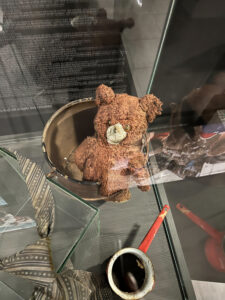
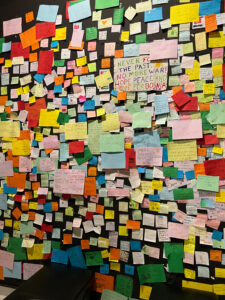


That afternoon, I took a free walking tour with Sheva Walking Tours that lasted over 3 hours. The guide, Sevko, shared an amount of information that would have been well-suited for a graduate level seminar. I found it riveting. It was easy to tell how important it was to him that everyone come away with a better understanding of his country and the conflict there. He told us that there was a common conception that the war was about religion—a conflict between the Croatian Catholics, the Bosnian Muslims, and the Serbian Orthodox Christians. But it wasn’t, he says. It was about nationalism. And nationalism is what still divides the city today. The citizens who live on one side of the dividing line rarely venture to the other side. The same is true in Sarajevo—a rule that everyone understands. We stood on the edge of the dividing line as a group—just a regular street across which lived residents of the same city with the same jobs, same lives, same hopes and dreams, even identical in appearance. And yet, across that line, people are considered the enemy. The two sides of town have their own water plants, their own energy companies, their own transit systems, and they even teach different lessons in their schools based on the ethnicity of their students. It never becomes less shocking to think about what people are capable of doing to one another. I walked back to my room through the cemetery that used to be a city park before the war. It’s where they buried everyone when the siege started—they had no way to get bodies anywhere else.

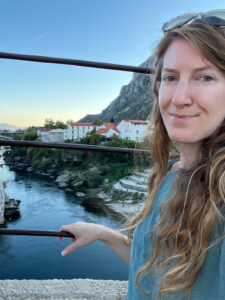
Bosnia and Herzegovina is an impossibly complicated country with so many negative things working against it. They’re the second poorest country in Europe behind only Moldova, and they have the highest unemployment rate in Europe (37%). There’s a ton of corruption and a still-fresh memory of the bloodiest genocide in Europe since the Holocaust. They have every reason to be bitter and angry. And in spite of those things, the people I met on both of my visits to Bosnia were the kindest and most generous. They have this unimaginable resilience, and they don’t take things for granted. This place is spectacularly beautiful.
I left the next morning on a bus back to Croatia. The fog below us in the valleys was the thickest I’d ever seen. After 3 more nights in Bosnia, it still felt like nowhere near enough.
